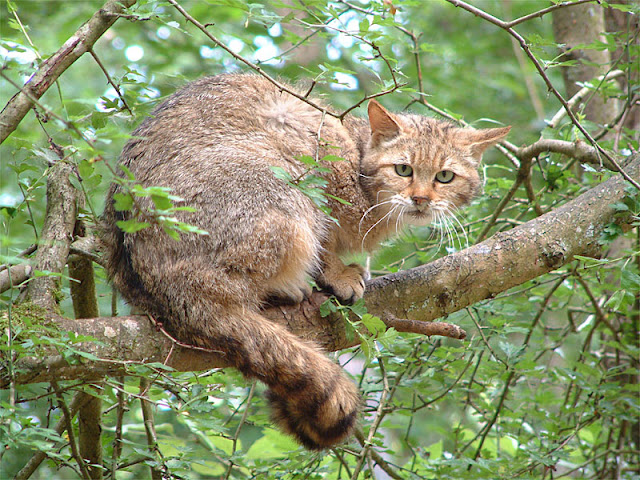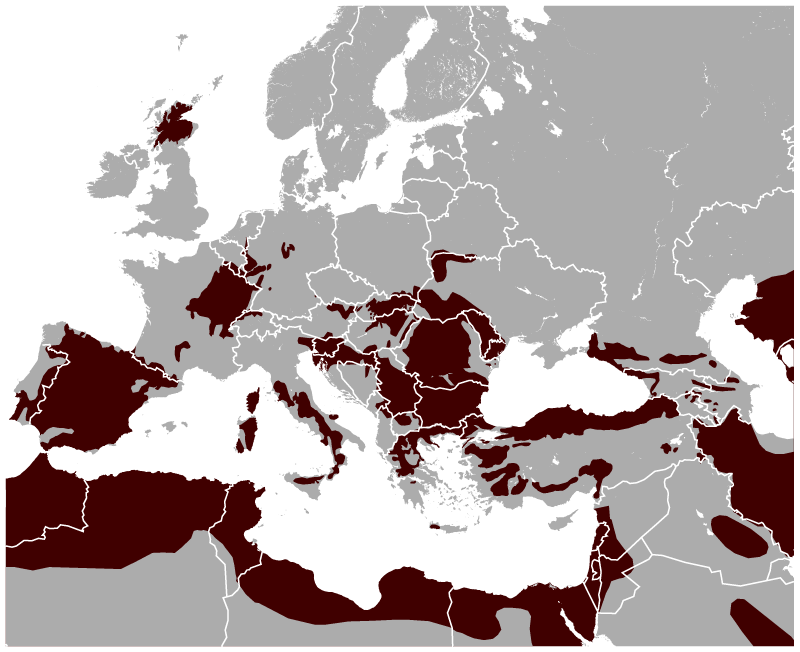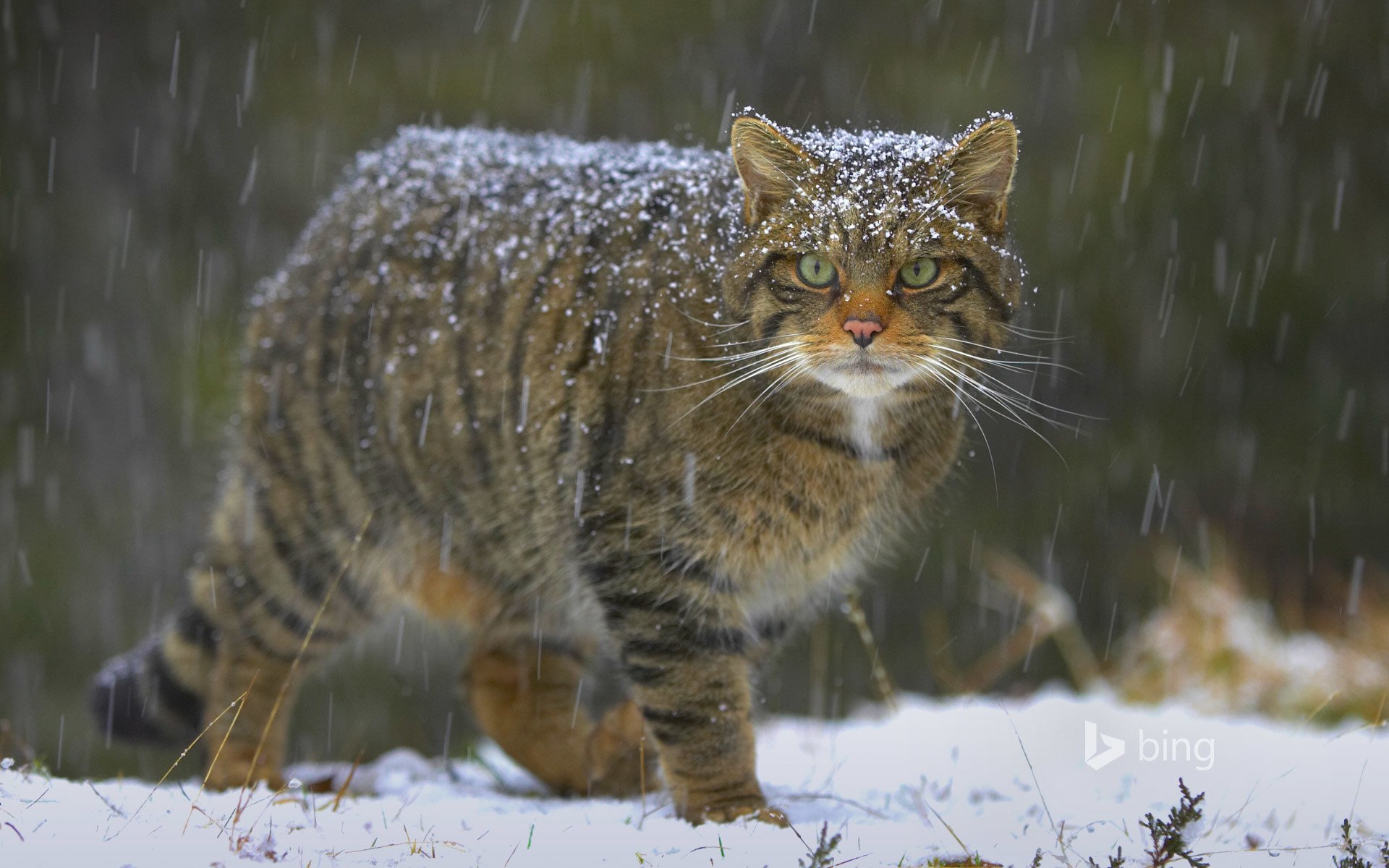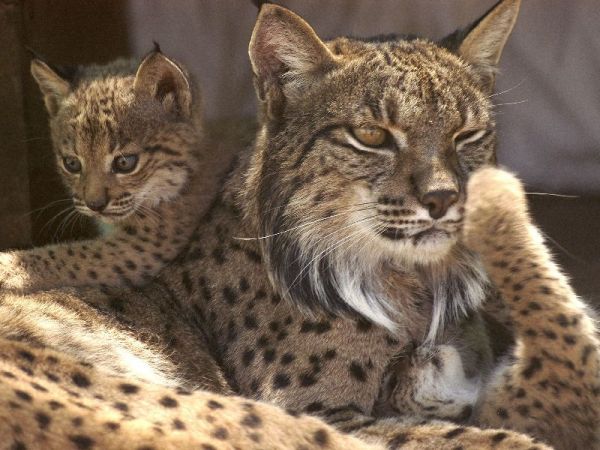In France, European wildcats are predominantly nocturnal, but are also active in the daytime when undisturbed by human activities.[4][5]
Populations in Scotland, the Mediterranean islands, Turkey, and Caucasus used to be considered separate wildcat subspecies and distinct from wildcats occurring on the European mainland.[1]

Characteristics
Closeup of head, Germany
Large males in Spain reach 65 cm (26 in) in length, with a 34.5 cm (13.6 in) long tail, and weigh up to 7.5 kg (17 lb). They also have a less diffuse stripe pattern, proportionally larger teeth, and feed more often on rabbits than the wildcats north of the Douro-Ebro, which are more dependent on small rodents.[8]
Since European wildcats and domestic cats interbreed, it is difficult to distinguish European wildcats and striped hybrids correctly on the basis of only morphological characters.[9]
Distribution and habitat

European wildcats live primarily in broad-leaved and mixed forests. They avoid intensively cultivated areas and settlements.[10] The northernmost population lives in northern and eastern Scotland.[11] There are two disconnected populations in France. The one in the Ardennes in the country's north-east extends to Luxembourg, Germany and Belgium. The other in southern France may be connected via the Pyrenees to populations in Spain and Portugal.[12] In Germany, the Rhine is a major barrier between the population in Eifel and Hunsrück mountains west of the river and populations east of the river, where a six-lane highway hampers dispersal.[13] The population in the Polish Carpathian Mountains extends to northern Slovakia and western Ukraine.[14][15] In Switzerland, wildcats are present in the Jura Mountains.[16] Three fragmented populations in Italy comprise one in the country's central and southern part, one in the eastern Alps that may be connected to populations in Slovenia and Croatia. The Sicilian population is the only Mediterranean insular population that has not been introduced.[17]
Evolution

In European Pleistocene deposits, remains of small cats are not common, and indicate a close relationship to the European wildcat.[18]
Threats
In most European countries, European wildcats have become rare. Although legally protected, they are still shot by people mistaking them for feral cats. In the Scottish Highlands, where approximately 400 were thought to remain in the wild in 2004, interbreeding with feral cats is a significant threat to the wild population's distinctiveness.[19] The greatest population of wildcats lives in Spain and Portugal but is threatened by interbreeding with feral cats and loss of habitat.[20][21] In the 1990s, the easternmost population in Ukraine, Moldova, and the Caucasus was threatened by destruction of broad-leaved forests, entailing a reduction of their range. Only small numbers occur in protected areas.[22]Conservation efforts
In Scotland
Distribution of five Felis silvestris subspecies recognised by a 2007 DNA study.[23] The dark blue areas in Europe, Turkey and the Caucasus show the current distribution of the European wildcat (Felis silvestris silvestris); the lighter blue areas in Europe show the regions where it has become extinct.
In September 2012, following a review of 2,000 records including camera trapping photographs, sighting reports, and road kills, the Scottish Wildcat Association (SWA) warned that Scottish wildcats could be extinct within a short time, because only 35 pure wildcats survive in the wild.[28] A severe reduction of rabbit populations due to myxomatosis has hastened the wildcat's decline.[29] In 2013, the Royal Zoological Society of Scotland encouraged collection of biological material, but considered cloning as an option only after "all other avenues have been exhausted".[30]
In September 2013, the Aspinall Foundation announced plans to develop an in-situ captive breeding centre on the island of Càrna, off the west coast of Scotland at Ardnamurchan.[31] The Scottish Wildcat Association had developed the Wildcat Haven project on this peninsula to identify pure Scottish wildcats and neuter feral cats, using a genetic test to identify hybridisation in Scottish wildcats.[32][33]
The news was followed by an SNH announcement to launch a new wildcat Action Plan taking a more "pragmatic" approach to conserve wildcats and hybrids exhibiting wildcat features using a relaxed definition of the wildcat.[34][35] The founder and former chairman of the Scottish Wildcat Association however considered the approach a "shameful effort" that would force the Scottish wildcat into extinction.[34][36][37]
In July 2014, the Wildcat Haven project announced the successful neutering of feral and hybrid cats across 250 sq mi (650 km2) of the West Highlands, creating a protected zone for the Scottish wildcat.[38][39]
On March 9, 2016, an ambitious project was announced to allocate more than 800 square miles of the west Scottish Highlands and to create a further 7,000 square mile haven for wildcats.[40][41] Chief scientist Paul O'Donoghue said: “We have now developed a proven template for wildcat conservation that can be rolled out across the western Highlands. Eight hundred square miles can home around 100 true Scottish wildcats, but our aim is a 7,000 square mile threat-free area that could hold a sustainable population and save them from extinction. Wildcat Haven is living proof that the Scottish wildcat can and must be saved in the wild where they belong. It's all about hybridisation. The wildcat is a very capable survivor and prefers to breed with other wildcats, but it's so outnumbered by domestic cats that hybridisation is inevitable. This means that over a few generations, those wildcat genes are lost, and you're just left with domestic and feral cats causing big problems for prey species and themselves.”[40][41] Scottish Wildcat Action,[42] is another project to save Scottish Wildcats involving six priority areas: Strathpeffer, Strathbogie, Strathavon, Morvern, North Strathspey and the Angus Glens.[43]
Taxonomy
European Wildcat in a zoo in Děčín, Czech Republic
Two different forms often are identified in the Iberian Peninsula: the common European form, north of the Douro and Ebro Rivers, and a "giant" Iberian form, sometimes considered a different subspecies F. s. tartessia, in the rest of the region.[44] The palaeontologist Björn Kurtén noted that the disputed "Tartessian" subspecies has uniquely kept the same size and proportions as the form that was found throughout mainland Europe during the Ice Ages of the Pleistocene.[18] The habitat of both forms also is different: the northern, typical population lives mainly in deciduous Quercus robur forests and the southern, large type in Mediterranean evergreen Quercus ilex forests.[8]









No comments:
Post a Comment
Note: Only a member of this blog may post a comment.